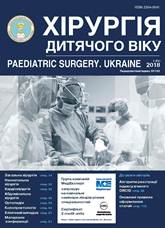Effect of the balloon dilatation of pulmonary stenosis on the pulmonary artery branches growth in patients with fallot’s tetrad
DOI:
https://doi.org/10.15574/PS.2018.59.41Keywords:
balloon pulmonary valvuloplasty, Fallot’s tetrad, endovascular surgeryAbstract
Objective: to determine the efficacy of balloon dilatation of pulmonary artery stenosis as a palliative procedure for optimization of pulmonary blood flow in patients with the tetralogy of Fallot that require stage treatment.Material and methods. During the period from January 2007 to December 2016, a balloon dilatation of pulmonary stenosis was performed in 121 patients with Fallot’s tetrad. The average age of patients was 53.5±34.2 days (from 2 days to 6 months), and the average weight was 4.1±1.1 kg (from 1.2 to 7 kg). The effect of balloon dilatation on the cyanosis, growth of valves, branches of the pulmonary artery and the left ventricle was studied.
Results. As a result of balloon dilatation of pulmonary stenosis, arterial oxygen saturation of the arterial blood increased from 81.2±11.2 (from 30 to 98)% to 93.1±6.6 (from 40 to 100)% (p<0.001). The diameter of the pulmonary valve increased from 6.4±1.2 (from 4 to 9.5) mm to 7.6±2.1 (from 4 to 15) mm (p<0.001). The Nakata index increased from 112±4.2 (from 47 to 274) mm2/m2 to 152±58 (from 59 to 436) mm2/m2. The end-diastolic index of the left ventricle increased from 30.3±9.3 (from 5 to 61) ml/m2 to 35.4±13.5 (from 12 to 73) ml/m2. Radical correction of the defect was performed in 96 (79%) patients without additional palliative interventions.
Conclusions. Balloon dilatation of pulmonary artery stenosis is an effective method of optimizing pulmonary blood flow in patients with the Fallot’s tetrad. It provides the growth of the valve, branches of the pulmonary artery, left ventricle and allows avoiding additional palliative operations in 79% of cases.
References
Al Habib, Jacobs HF, Mavroudis JP et al. (2010). Contemporary patterns of management of tetralogy of Fallot: data from the Society of Thoracic Surgeons Database. Ann Thorac Surg. 90: 813-819. https://doi.org/10.1016/j.athoracsur.2010.03.110; PMid:20732501
Araba M, Kholeifa E, Zahera R et al. (1999). Balloon dilation of the right ventricular outflow tract in tetralogy of Fallot: a palliative procedure. Cardiology in the Young. 9; Is 01: 11-16.
Barron DJ. (2013). Tetralogy of Fallot: controversies in early management. World J Pediatr Congenit Heart Surg. 4: 186-191. https://doi.org/10.1177/2150135112471352; PMid:23799733
Marshall L Jacobs, Luca A Vricella. (2013, Dec.). Surgical management of tetralogy of Fallot: where are we now and what is yet to come. Cardiology in the young. 23; 6: 933-937. https://doi.org/10.1017/S1047951113001959
Ooi A, Moorjani N, Baliulis G, Keeton BR, Salmon AP, Monro JL et al. (2006). Medium term outcome for infant repair in tetralogy of Fallot: indicators for timing of surgery. Eur J Cardiothorac Surg. 30: 917-22. https://doi.org/10.1016/j.ejcts.2006.08.022
Sarris GE, Comas JV, Tobota Z, Maruszewski B. (2012). Results of reparative surgery for tetralogy of Fallot: data from the European Association for Cardio-Thoracic Surgery Congenital Database. Eur J Cardiothorac Surg. 42:766–774. https://doi.org/10.1093/ejcts/ezs478; PMid:23087090
Downloads
Issue
Section
License
The policy of the Journal “PAEDIATRIC SURGERY. UKRAINE” is compatible with the vast majority of funders' of open access and self-archiving policies. The journal provides immediate open access route being convinced that everyone – not only scientists - can benefit from research results, and publishes articles exclusively under open access distribution, with a Creative Commons Attribution-Noncommercial 4.0 international license(СС BY-NC).
Authors transfer the copyright to the Journal “PAEDIATRIC SURGERY.UKRAINE” when the manuscript is accepted for publication. Authors declare that this manuscript has not been published nor is under simultaneous consideration for publication elsewhere. After publication, the articles become freely available on-line to the public.
Readers have the right to use, distribute, and reproduce articles in any medium, provided the articles and the journal are properly cited.
The use of published materials for commercial purposes is strongly prohibited.

